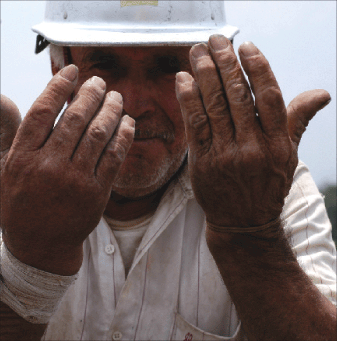Social ferment in annual Latin conclave
Juan Carlos Rulfo’s documentary “In the Pit,” screening in this year’s edition of “Latin Beat” at the Walter Reade, begins like an old-fashioned process study—a dam is erected, a ship is assembled, a candidate sold. Now a road is being built. The Periférico, a giant autobahn girdling Mexico City, is having a second tier installed, meant to relieve the capital’s chronic gridlock by lofting commuters between areas on an elevated ribbon.
But first the city has to endure the construction job, making traffic worse before it improves. Rigs bearing massive concrete segments crawl down nocturnal streets, and skeletal piers rise everywhere. With this commotion as backdrop, “In the Pit” subdivides into capsule portraits of one construction crew that yield an absorbing cross-section of Mexican masculinities. “Shorty” and “El Grande” emerge as primary mouthpieces. Gentle and circumspect, Shorty is the yin to El Grande’s yang. Rulfo has them rattle off their skills to get things going—they both do a little of everything, “except as a faggot,” El Grande adds.
By contrasting drilling, masonry, etc. with homosexuality, his gibe reproduces the hoary active/passive cultural binary in which a pliant, receptive male is always a tainted maricón, yet a rugged macho can enjoy insertive buttsex at whim without social opprobrium, the idea being that sexual gratification is a “real man” ’s absolute birthright, regardless of who provides it. Besides this, El Grande is also testing the educated, liberal Rulfo’s sensibility, and using humor to accept and welcome him to the crew.
Once the virile bona fides are established and the crew starts ignoring the camera, the guys, thrown together day after day in the closest proximity, hardly keep their hands off each other. Slapping, poking, kneading, mussing, pulling wedgies—in short, a more homoerotically charged setting than Tuesday nights at Beige. The surprise comes from the range of variations within this gallery. If demure Shorty stands at one pole, his antipode is the almost hysterically exaggerated foreman Vicencio Martínez. Off-hours, he’s an urban charro, decked in lancet-toed boots, bulge-hugging trousers, and an elbow-length ponytail waving from under his Stetson. Rulfo follows Vicencio on a weekend equestrian outing, and shoots him on a charging mustang, tresses flying.
“In the Pit” concludes with an elaborate 7-minute aerial shot, gliding along the unfinished serpentine road, but the gaudy exclamation point doesn’t dispel an impression of flaccid structure and loosely integrated components. The time-lapse footage telescoping the construction’s progress suffers from stock-agency prettiness. Vertiginous angles taken from rickety scaffolding high above traffic help us appreciate the risk involved yet convey only a meager sense of what the men’s labor actually consists of, or how it’s done. The lone female speaking part, a ponderous guard who recurs through the brawny action, adds so little that she seems almost a token. And Rulfo is disinclined to press the men beyond genial platitudes and such maxims as “Those born in a flowerpot never leave the terrace”—though their silences are often as meaningful as their words.
If you can catch only one program in “Latin Beat,” the unmissable highlight is a single screening, on September 17, of “Canoa” (1975) by Felipe Cazals, shown in a sweet new print struck for its 30th-anniversary toast at Cannes last year. A defining work of the Mexican cinema and lynchpin of Cazals’ mid-1970s trilogy—completed by the prison saga “El Apando” and the whores’ jeremiad “Los Poquianchis”—“Canoa” appears across three decades’ distance as a prophetic warning against corrupt religious authority and the susceptibility of the uneducated poor to manipulated fears and resentments.
A sustained crescendo of unease, the film was modeled closely on actual events of September 14, 1968, which are figured as both portent and displacement of the following month’s massacre of students by military and police at Tlatelolco in Mexico City. Tomás Pérez Turrent’s script introduces a quintet of young friends at the University of Puebla who decide to take an early-semester camping jaunt to the slope of the volcano La Malinche. Looking back at 1968 from the tail end of the Echeverría sexenio, Cazals takes time to let us enjoy the boys’ camaraderie, goofy banter, and vagabond chic. Setting off in a rustheap, they’re delayed by suddenly nasty weather and pull up in the arid, isolated village of San Miguel de Canoa.
Out here the hills have eyes, and before the lads have asked innocuously at the church about an overnight billet, the place is already aquiver with nervous speculation. They don’t see many strangers, but hospitality is unforthcoming not just for want of practice. The cleric Meza (Enrique Lucero), who rules this backwater like a sovereign liege, eggs the peasants into thinking the boys are communist agents and, while we’re at it, child-robbing janissaries. As panic mushrooms, the campers manage to find lodging with a farmer, yet their reprieve is brief. Toward midnight, seemingly the entire village surrounds the farmer’s cabin, and the Walpurgisnacht that ensues before state troopers arrive belongs with the most harrowing depictions of mob violence rendered on film.
gaycitynews.com



































